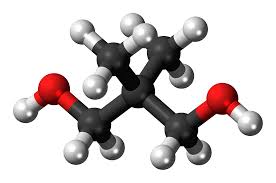Neopentyl glycol

- Neopentyl glycol (IUPAC name 2,2-dimethyl-1,3-propanediol) is an organic chemical compound. It is used in the synthesis of polyesters, paints, lubricants, and plasticizers. When used in the manufacture of polyesters, it enhances the stability of the product towards heat, light, and water.
- By esterification reaction with fatty or carboxylic acids, synthetic lubricating esters with reduced potential for oxidation or hydrolysis, compared to natural esters, can be produced.
- Neopentyl glycol(NPG) is synthesized industrially by the aldol reaction of formaldehyde and isobutyraldehyde. This creates the intermediate hydroxypivaldehyde, which can be converted to neopentyl glycol with either excess formaldehyde or catalytic hydrogenation of the aldehyde group to an alcohol group.
- NPG is used primarily in base resins for coatings. Important uses are also found in hydraulic fluids, synthetic lubricant oils and aircraft engine lubricants. Other outlets include textiles, pharmaceuticals, pesticides and plasticisers. NPG is shipped as flake, molten and slurry.
- Neopentyl Glycol is a white crystalline material in flakes or colourless liquid in molten from.
No comments:
Post a Comment